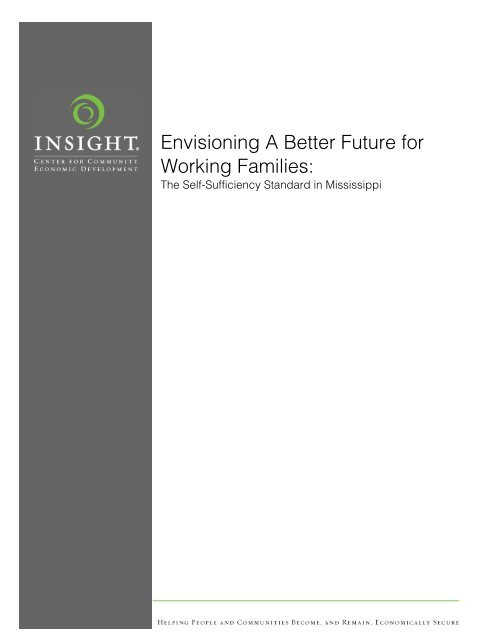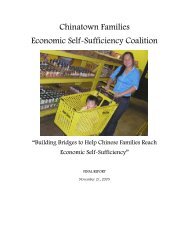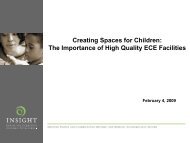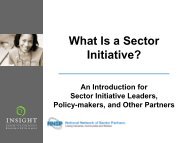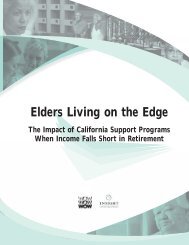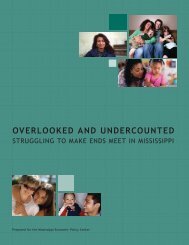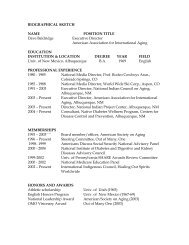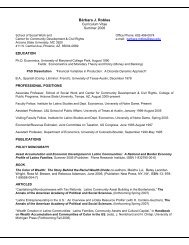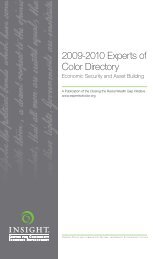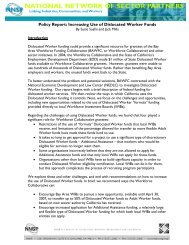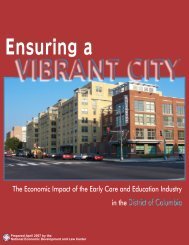Envisioning a Better Future for Working Families in Mississippi
Envisioning a Better Future for Working Families in Mississippi
Envisioning a Better Future for Working Families in Mississippi
Create successful ePaper yourself
Turn your PDF publications into a flip-book with our unique Google optimized e-Paper software.
<strong>Envision<strong>in</strong>g</strong> A <strong>Better</strong> <strong>Future</strong> <strong>for</strong><br />
<strong>Work<strong>in</strong>g</strong> <strong>Families</strong>:<br />
The Self-Sufficiency Standard <strong>in</strong> <strong>Mississippi</strong>
About the Insight Center<br />
The Insight Center <strong>for</strong> Community Economic Development, <strong>for</strong>merly the National Economic Development<br />
and Law Center (NEDLC), is a national research, consult<strong>in</strong>g, and legal organization dedicated to build<strong>in</strong>g<br />
economic health <strong>in</strong> disenfranchised communities. The Insight Center's multidiscipl<strong>in</strong>ary approach utilizes a<br />
wide array of community economic development strategies <strong>in</strong>clud<strong>in</strong>g promot<strong>in</strong>g <strong>in</strong>dustry-focused work<strong>for</strong>ce<br />
development, build<strong>in</strong>g <strong>in</strong>dividual and community assets, establish<strong>in</strong>g the l<strong>in</strong>k between early care and<br />
education and economic development, and advocat<strong>in</strong>g <strong>for</strong> the adoption of the Self-Sufficiency Standard as<br />
a measurement of <strong>in</strong>come adequacy. For more <strong>in</strong><strong>for</strong>mation visit: www.<strong>in</strong>sightcced.org.<br />
About the National Economic Security Initiative<br />
The Insight Center was a found<strong>in</strong>g partner of the Family Economic Self-Sufficiency Project (FESS), an<br />
<strong>in</strong>novative, nationwide ef<strong>for</strong>t to promote proven strategies that help low-<strong>in</strong>come families reach economic selfsufficiency.<br />
Today, we work to expand this movement nationally, and lead the Cali<strong>for</strong>nia arm, known as<br />
Cali<strong>for</strong>nians <strong>for</strong> Economic Security (CFES), a coalition with more than 400 members. In 2008, we launched<br />
the Cali<strong>for</strong>nia Elder Economic Security Initiative (Cal-EESI), which extends this work to help retired, older<br />
adults age with dignity and economic well-be<strong>in</strong>g.<br />
Susan E. Smith is the pr<strong>in</strong>cipal author of this report. The follow<strong>in</strong>g staff members played <strong>in</strong>strumental roles <strong>in</strong><br />
produc<strong>in</strong>g this report: Lauren Berkman assisted with conduct<strong>in</strong>g the <strong>in</strong>terviews; Anagha Dange assisted with<br />
analyz<strong>in</strong>g the <strong>in</strong>terviews and writ<strong>in</strong>g; Jenny Chung, Susie Suafai, and Lori Warren; edited the report; and<br />
Esther Polk and LaVerne Gardner <strong>for</strong>matted the report.<br />
Acknowledgements<br />
The Insight Center would like to thank the Enterprise Corporation of the Delta <strong>for</strong> their outstand<strong>in</strong>g leadership<br />
on the Self-Sufficiency Standard project <strong>in</strong> <strong>Mississippi</strong> and <strong>for</strong> identify<strong>in</strong>g local leaders to <strong>in</strong>terview <strong>for</strong> this<br />
report. We would also like to the Children’s Defense Fund Southern Regional Office <strong>for</strong> their leadership <strong>in</strong><br />
help<strong>in</strong>g to educate communities about the Self-Sufficiency Standard and <strong>for</strong> connect<strong>in</strong>g us to local<br />
organizations to <strong>in</strong>terview.<br />
We want to express our s<strong>in</strong>cere appreciation to the twenty-four leaders who took the time out of their busy<br />
schedules to be <strong>in</strong>terviewed <strong>for</strong> this report. Without their assistance, this report would not have been<br />
possible. A list of those leaders can be found <strong>in</strong> Appendix B.<br />
F<strong>in</strong>ally, we would like to thank the W. K. Kellogg Foundation <strong>for</strong> their generous support of this project.
Table of Contents<br />
Introduction ...................................................................................................................................... 1<br />
Methodology .................................................................................................................................... 2<br />
Interview F<strong>in</strong>d<strong>in</strong>gs ............................................................................................................................ 3<br />
Awareness of the Self-Sufficiency Standard ............................................................................. 3<br />
Current and Past Uses of the Self-Sufficiency Standard .......................................................... 4<br />
<strong>Future</strong> Uses of the Self-Sufficiency Standard ........................................................................... 4<br />
Challenges Us<strong>in</strong>g the Self-Sufficiency Standard ...................................................................... 8<br />
Conclusions and Recommendations ............................................................................................... 9<br />
Appendix A .................................................................................................................................... 12<br />
Appendix B .................................................................................................................................... 14
Introduction & Background<br />
The Self-Sufficiency Standard (the Standard) measures how much <strong>in</strong>come is needed <strong>for</strong> work<strong>in</strong>g families to<br />
cover their most basic expenses: hous<strong>in</strong>g, food, child care, health care, transportation, and state and federal<br />
taxes. Draw<strong>in</strong>g from widely-recognized, public data sources such as the US Department of Agriculture and<br />
the US Department of Hous<strong>in</strong>g, the Self-Sufficiency Standard varies by family composition and county of<br />
residence. 1 First developed <strong>in</strong> 1995 by Dr. Diana Pearce as part of a project <strong>for</strong> Wider Opportunities <strong>for</strong><br />
Women (WOW), the Standard is an organiz<strong>in</strong>g and program development tool <strong>for</strong> agencies across the<br />
country and provides a more accurate metric of basic needs than the often-cited, but outdated Federal<br />
Poverty Guidel<strong>in</strong>es.<br />
A recent study found that one out of every three non-elderly households <strong>in</strong> <strong>Mississippi</strong> does not have enough<br />
<strong>in</strong>come to meet their most basic needs, as def<strong>in</strong>ed by the Self-Sufficiency Standard. 2 This group of<br />
struggl<strong>in</strong>g <strong>Mississippi</strong>ans is neither small nor marg<strong>in</strong>al, but rather represents a substantial and diverse<br />
proportion of the state. It <strong>in</strong>cludes married couples with children, full-time work<strong>in</strong>g parents, men, women, and<br />
representatives from all racial and ethnic groups <strong>in</strong> the state. The scope of the problem is so large that it<br />
constitutes a crisis.<br />
The question is: what can be done to help <strong>Mississippi</strong> families move along a path toward economic security?<br />
What programmatic and policy advocacy strategies are local leaders spearhead<strong>in</strong>g to enable families to<br />
reach economic stability, and how can tools like the Self-Sufficiency Standard strengthen exist<strong>in</strong>g ef<strong>for</strong>ts?<br />
In 2009, the Insight Center <strong>for</strong> Community Economic Development began a project, Build<strong>in</strong>g Economic<br />
Security <strong>in</strong> <strong>Mississippi</strong>, to expand the capacity of local organizations to develop, ma<strong>in</strong>ta<strong>in</strong>, and engage a<br />
statewide coalition of diverse stakeholders around family economic security, us<strong>in</strong>g the Standard as an<br />
organiz<strong>in</strong>g framework. Specifically, we partnered with the Enterprise Corporation of the Delta (ECD), the<br />
organization which has housed the Standard <strong>in</strong> <strong>Mississippi</strong> s<strong>in</strong>ce 2003, and the Children's Defense Fund<br />
Southern Regional Office (CDF), an organization which leads several effective statewide and regional<br />
<strong>in</strong>itiatives to reduce childhood poverty <strong>in</strong> the region.<br />
Phase I of Build<strong>in</strong>g Economic Security <strong>in</strong> <strong>Mississippi</strong> <strong>in</strong>cluded the follow<strong>in</strong>g key steps which were completed<br />
<strong>in</strong> 2009 <strong>in</strong> partnership with ECD, CDF, and WOW. Together, we:<br />
1. Created a Build<strong>in</strong>g Economic Security <strong>in</strong> <strong>Mississippi</strong> Advisory Committee of local leaders;<br />
2. Conducted a statewide scan and qualitative <strong>in</strong>terviews of 23 local organizations help<strong>in</strong>g families<br />
move toward economic security to assess their usage of the Self-Sufficiency Standard;<br />
3. Updated and released a 2009 Self-Sufficiency Standard reflect<strong>in</strong>g the current costs of meet<strong>in</strong>g basic<br />
needs <strong>for</strong> families <strong>in</strong> each county of <strong>Mississippi</strong>;<br />
1 Diana Pearce has calculated the Self-Sufficiency Standard us<strong>in</strong>g the same methodology <strong>for</strong> 37 states and the District of Columbia.<br />
WOW cont<strong>in</strong>ues to lead national advocacy around adopt<strong>in</strong>g the Self-Sufficiency Standard <strong>in</strong> Wash<strong>in</strong>gton, D.C.<br />
2 Dr. Diana Pearce, Center <strong>for</strong> Women’s Welfare, School of Social Work, University of Wash<strong>in</strong>gton, Overlooked and Undercounted,<br />
Struggl<strong>in</strong>g to Make Ends Meet <strong>in</strong> <strong>Mississippi</strong> (2009). http://www.mepconl<strong>in</strong>e.org/images/adm<strong>in</strong>/spotedit/attach/0/ECD_nb.pdf; and<br />
http://www.selfsufficiencyStandard.org/docs/<strong>Mississippi</strong>%20Demographic%202009.pdf.<br />
<strong>Envision<strong>in</strong>g</strong> a <strong>Better</strong> <strong>Future</strong> <strong>for</strong> <strong>Work<strong>in</strong>g</strong> <strong>Families</strong>—February, 2010 Page 1
4. Increased the capacity of local organizations to use and promote the Self-Sufficiency Standard<br />
throughout the state;<br />
5. Produced Overlooked and Undercounted: Struggl<strong>in</strong>g to Make Ends Meet <strong>in</strong> <strong>Mississippi</strong>, the study<br />
referenced above, which details the number and demographic profile of families liv<strong>in</strong>g on <strong>in</strong>comes<br />
below the Self-Sufficiency Standard <strong>in</strong> <strong>Mississippi</strong>; and<br />
6. Increased the visibility of the Standard, so that local stakeholders now have a better understand<strong>in</strong>g<br />
of what it actually takes families to make ends meet <strong>in</strong> <strong>Mississippi</strong>.<br />
By provid<strong>in</strong>g new tools, tra<strong>in</strong><strong>in</strong>g materials, messages, and policy and programmatic consultation <strong>in</strong><br />
coord<strong>in</strong>ation with our national partner, WOW, the project is help<strong>in</strong>g local practitioners, advocates, and<br />
policymakers become aware of and beg<strong>in</strong> to <strong>in</strong>tegrate the Self-Sufficiency Standard <strong>in</strong>to local programs and<br />
policy development. For, <strong>in</strong> order to ultimately help families reach economic stability, we first need to have<br />
an accurate and realistic understand<strong>in</strong>g of how much it actually takes to cover basic needs <strong>in</strong> <strong>Mississippi</strong>.<br />
Over the next few years, we hope to strengthen the capacity of local organizations to <strong>in</strong>tegrate the Standard<br />
<strong>in</strong>to local practices and policies and build an effective statewide coalition unified around the goal of<br />
economic security <strong>for</strong> all <strong>Mississippi</strong> residents.<br />
Based on an analysis from <strong>in</strong>terviews of twenty-three organizations across <strong>Mississippi</strong>, this report<br />
assesses the current application—and the potential future application—of the Self-Sufficiency<br />
Standard <strong>in</strong> <strong>Mississippi</strong>. It should be noted from the outset, however, that until the creation of ECD’s<br />
<strong>Mississippi</strong> Economic Policy Center (MEPC) <strong>in</strong> 2007, ECD did not have the resources or staff capacity to<br />
lead a statewide ef<strong>for</strong>t to educate organizations about the Standard and help them <strong>in</strong>tegrate it <strong>in</strong>to their<br />
work. The creation of MEPC, comb<strong>in</strong>ed with a recent <strong>in</strong>vestment from the W. K. Kellogg Foundation, now<br />
makes the application of the Standard more likely to be realized <strong>in</strong> the future. The release of the Standard <strong>in</strong><br />
2009, along with the 2009 demographic study on people liv<strong>in</strong>g below the Standard, have catalyzed much<br />
more <strong>in</strong>terest <strong>in</strong> the tool, largely due to a successful outreach strategy by ECD. <strong>Mississippi</strong> leaders are now<br />
well-positioned to take the next steps to better measure and eventually address poverty <strong>in</strong> the state.<br />
This report proceeds as follows. Section I discusses the research methodology. Section II summarizes the<br />
<strong>in</strong>terview f<strong>in</strong>d<strong>in</strong>gs, <strong>in</strong>clud<strong>in</strong>g a discussion of: the awareness of the Self-Sufficiency Standard with<strong>in</strong><br />
<strong>Mississippi</strong>, current and potential future use of the Standard, and challenges associated with <strong>in</strong>tegrat<strong>in</strong>g the<br />
tool <strong>in</strong>to local programs and policies. Section III concludes with recommendations on how to use the<br />
Standard to build a coalition united around family economic stability <strong>in</strong> <strong>Mississippi</strong>.<br />
Overall, we found that policymakers, advocates, service providers and funders all see tremendous potential<br />
<strong>in</strong> the Standard’s ability to help improve the lives of work<strong>in</strong>g families <strong>in</strong> <strong>Mississippi</strong>, today and <strong>in</strong> the future.<br />
Methodology<br />
The Insight Center <strong>in</strong>terviewed leaders from twenty-three organizations <strong>in</strong> order to assess familiarity, current<br />
use, and the potential of future adoption of the Self-Sufficiency Standard <strong>in</strong> <strong>Mississippi</strong> programs and<br />
policies. A secondary purpose was to educate local stakeholders unfamiliar with the Standard about its<br />
potential so that these organizations would be <strong>in</strong><strong>for</strong>med and eager to use the Standard and jo<strong>in</strong> a new selfsufficiency<br />
movement <strong>in</strong> <strong>Mississippi</strong>.<br />
With consultation from ECD and CDF, the Insight Center identified organizations from across the state which<br />
had family support programs or policy <strong>in</strong>itiatives. We selected organizations to <strong>in</strong>terview from each region of<br />
<strong>Envision<strong>in</strong>g</strong> a <strong>Better</strong> <strong>Future</strong> <strong>for</strong> <strong>Work<strong>in</strong>g</strong> <strong>Families</strong>—February, 2010 Page 2
the state (Capital/River, Delta, Gulf Coast, Hills, and P<strong>in</strong>es) and sampled different types of organizations<br />
(service organizations, advocacy organizations, public agencies, foundations, research <strong>in</strong>stitutions, and the<br />
private sector). Most of the organizations <strong>in</strong>terviewed were supported by the W. K. Kellogg Foundation so<br />
that the research f<strong>in</strong>d<strong>in</strong>gs could also <strong>in</strong><strong>for</strong>m Kellogg’s grant mak<strong>in</strong>g and help to improve organizational<br />
practices over time. The <strong>in</strong>terviewees were mostly executive directors of their organizations or other top-level<br />
management.<br />
The 23 organizations <strong>in</strong>cluded:<br />
• 7 non-profit direct service providers,<br />
• 4 non-profit advocacy organizations,<br />
• 2 non-profit advocacy and direct service organizations,<br />
• 4 public agencies,<br />
• 3 research <strong>in</strong>stitutions,<br />
• 2 foundations, and<br />
• 1 <strong>in</strong>vestment firm.<br />
We asked questions related to:<br />
• Organizational policies and programs,<br />
• Current use of the Self-Sufficiency Standard,<br />
• Potential future uses of the Self Sufficiency Standard with<strong>in</strong> their organizations,<br />
• Potential future uses of the Standard across similar organizations <strong>in</strong> the state and at the state and<br />
local legislative levels, and<br />
• Challenges <strong>in</strong> <strong>in</strong>tegrat<strong>in</strong>g the Standard <strong>in</strong> programs and policies.<br />
A template of the questions can be found <strong>in</strong> Appendix A. To encourage an open dialogue, remarks are not<br />
attributed to specific <strong>in</strong>dividuals. Rather, an overall list of the <strong>in</strong>terviewees and their organizations is attached<br />
<strong>in</strong> Appendix B.<br />
Interview F<strong>in</strong>d<strong>in</strong>gs<br />
Awareness of the Self-Sufficiency Standard<br />
Of the 23 organizations <strong>in</strong>terviewed, only three organizations were us<strong>in</strong>g the Standard <strong>in</strong> their work today.<br />
One organization used the 2003 version of the Standard, but then later found it outdated; two organizations<br />
were familiar with the Self-Sufficiency Standard, ten organizations had heard of the Standard, but did not<br />
know how it worked or what it really was, and 6 were neither familiar with nor aware of the Standard. While<br />
several organizations provided guidance to ECD when ECD first released the Standard <strong>in</strong> 2003 and others<br />
heard about it more recently <strong>in</strong> the plann<strong>in</strong>g around the 2009 release of the Standard, an overall f<strong>in</strong>d<strong>in</strong>g was<br />
that <strong>Mississippi</strong> organizations sampled were generally not that familiar with or us<strong>in</strong>g the Self-Sufficiency<br />
Standard today. This is not particularly surpris<strong>in</strong>g, however, s<strong>in</strong>ce, until recently, there was not significant<br />
support to launch a statewide educational campaign about the Standard. As a result, the <strong>in</strong>terview process,<br />
itself, became more <strong>in</strong>teractive with local stakeholders learn<strong>in</strong>g about the tool, and bra<strong>in</strong>storm<strong>in</strong>g how they<br />
could apply it <strong>in</strong> the future to their programs and advocacy work to help work<strong>in</strong>g families.<br />
<strong>Envision<strong>in</strong>g</strong> a <strong>Better</strong> <strong>Future</strong> <strong>for</strong> <strong>Work<strong>in</strong>g</strong> <strong>Families</strong>—February, 2010 Page 3
Current and Past Use of the Self-Sufficiency Standard<br />
Currently, ECD, the <strong>Mississippi</strong> Low-Income Child Care Initiative, and the National Community Tax Coalition<br />
–policy-oriented organizations <strong>in</strong> <strong>Mississippi</strong> – use the Standard <strong>for</strong> advocacy, public education,<br />
and/or fund development. As one child care advocate expla<strong>in</strong>ed,<br />
“We use it as an <strong>in</strong><strong>for</strong>mational tool to show why child care subsidies are so important.<br />
When press<strong>in</strong>g <strong>for</strong> more money to be put <strong>in</strong>to subsidies, we can talk about the difference it<br />
makes and give the message that child care is key to help<strong>in</strong>g people be able to work.<br />
Without subsidies, parents are not able to cover their other basic needs.”<br />
ECD uses the Standard to demonstrate the need <strong>for</strong> more fund<strong>in</strong>g <strong>for</strong> work<strong>for</strong>ce development programs, so<br />
that families can be tra<strong>in</strong>ed to enter <strong>in</strong>dustries that ultimately pay self-sufficiency wages. ECD has also used<br />
the Standard data <strong>in</strong> their reports, such as ECD’s Broaden<strong>in</strong>g the Base: Strengthen<strong>in</strong>g <strong>Mississippi</strong>’s <strong>Work<strong>in</strong>g</strong><br />
<strong>Families</strong>, Bus<strong>in</strong>esses and Economy Through Strong Child Care Systems, which highlighted unspent TANF<br />
funds and advocated that those dollars be redirected toward work<strong>for</strong>ce development and child care<br />
programs. ECD has used the Standard to evaluate the impact of their programs to measure, <strong>for</strong> example, if<br />
their commercial lend<strong>in</strong>g helped a bus<strong>in</strong>ess pay self-sufficiency<br />
level wages. F<strong>in</strong>ally, ECD cites the data <strong>in</strong> the Standard <strong>in</strong> oral<br />
testimony to the state legislature to support its overall policy<br />
work.<br />
While National Community Tax Coalition uses the Federal<br />
Poverty Guidel<strong>in</strong>es <strong>for</strong> research and advocacy “to skim the<br />
environment and show where people are at,” they use the Self-<br />
Sufficiency Standard “when it makes sense to pa<strong>in</strong>t a more<br />
detailed picture of low-<strong>in</strong>come folks and show where the gap<br />
lies.”<br />
“If the Self-Sufficiency<br />
Standard was tied to<br />
outcomes of the programs<br />
we fund, it could show if the<br />
organization is meet<strong>in</strong>g its<br />
goals.”<br />
Despite these examples, one research and advocacy<br />
organization concluded, “the Self-Sufficiency Standard has not yet affected advocacy <strong>in</strong> a mean<strong>in</strong>gful way”<br />
<strong>in</strong> <strong>Mississippi</strong>.<br />
<strong>Future</strong> Uses of the Standard<br />
The non-profit organizations <strong>in</strong>terviewed, be they advocates or direct service providers, reported that the<br />
Standard is capable of support<strong>in</strong>g the work of any organization work<strong>in</strong>g with low-<strong>in</strong>come communities and<br />
families s<strong>in</strong>ce it is a very valuable research and data source. The respondents were remarkably similar <strong>in</strong><br />
their perception and understand<strong>in</strong>g of possible uses of the Standard. This was reflected <strong>in</strong> their responses to<br />
the questions both on advantages and on challenges to adopt<strong>in</strong>g the Self-Sufficiency Standard. The only<br />
difference was the end use: either <strong>in</strong> public policy or programmatically. For example, compar<strong>in</strong>g the two<br />
largest groups of organizations i.e. direct service providers and advocacy organizations, the advocacy<br />
organization saw the Standard as a data and research tool to promote and back advocacy campaigns. It<br />
provides, as one leader put it, “a stronger base to make the case <strong>for</strong> family and work supports when talk<strong>in</strong>g<br />
to legislators, giv<strong>in</strong>g us an extra leg to stand on.” Similarly, service providers also saw the Standard as a<br />
research and data tool, but <strong>for</strong> program plann<strong>in</strong>g and expansion. As one work<strong>for</strong>ce development agency<br />
leader expla<strong>in</strong>ed, she envisioned us<strong>in</strong>g the Standard “to expand, establish, and retool exist<strong>in</strong>g programs.”<br />
<strong>Envision<strong>in</strong>g</strong> a <strong>Better</strong> <strong>Future</strong> <strong>for</strong> <strong>Work<strong>in</strong>g</strong> <strong>Families</strong>—February, 2010 Page 4
Another example of similarity was that the advocacy organizations saw the Standard as a tool to raise public<br />
awareness of the benefits they can access through federal, state, and local programs generally. Similarly, the direct<br />
service providers saw the same purpose of the Standard but, from their lens, to <strong>in</strong>crease enrollment of their direct<br />
client base <strong>in</strong> these programs.<br />
1. The Power of the Standard <strong>in</strong> Programs<br />
The <strong>in</strong>terviewees were asked to discuss what would happen if the Self-Sufficiency Standard were <strong>in</strong>tegrated<br />
with<strong>in</strong> their organizations’ programs. Leaders elaborated on a variety of benefits. General themes listed from<br />
most frequent to least frequent response are summarized <strong>in</strong> the bar-graph below.<br />
Us<strong>in</strong>g the Standard to benchmark and evaluate programs was one of the most common future<br />
applications of the Standard <strong>in</strong> programs among <strong>in</strong>terviewees. As one organization which makes subgrants<br />
expla<strong>in</strong>ed:<br />
“If the Self-Sufficiency Standard was tied to outcomes of the programs we fund, it could<br />
show if the organization is meet<strong>in</strong>g its goals and whether their programs are successful…<br />
the measure would show if the programs are gett<strong>in</strong>g people to self-sufficiency.”<br />
<strong>Envision<strong>in</strong>g</strong> a <strong>Better</strong> <strong>Future</strong> <strong>for</strong> <strong>Work<strong>in</strong>g</strong> <strong>Families</strong>—February, 2010 Page 5
Not only did the <strong>in</strong>terviewees envision us<strong>in</strong>g the Standard to<br />
measure the impact of their work, but they also reported that it<br />
could help them ga<strong>in</strong> access to new sources of fund<strong>in</strong>g<br />
because it quantifies a population that service providers<br />
hereto<strong>for</strong>e could only discuss anecdotally: families with<br />
<strong>in</strong>comes above the official poverty l<strong>in</strong>e, but below what it<br />
takes to make ends meet. Some respondents cited that they<br />
could use the Standard to demonstrate unmet needs of this<br />
population <strong>in</strong> grant applications. Leaders also expressed that<br />
the tool could improve organizations’ capacity <strong>in</strong> program<br />
plann<strong>in</strong>g and organizational strategic plann<strong>in</strong>g, enabl<strong>in</strong>g them to<br />
decide on core priorities mov<strong>in</strong>g <strong>for</strong>ward by answer<strong>in</strong>g the<br />
follow<strong>in</strong>g k<strong>in</strong>ds of questions: will this new program, subsidy, or<br />
“The Standard would change<br />
the whole face of what we do,<br />
if it became adopted…The<br />
Self-Sufficiency Standard,<br />
simply put, would change the<br />
way people look at receiv<strong>in</strong>g<br />
and giv<strong>in</strong>g assistance”.<br />
<strong>in</strong>itiative lower the dollar amount a person needs to be self-sufficient <strong>in</strong> our community? Will it <strong>in</strong>crease their<br />
earn<strong>in</strong>g power over time so they can earn self-sufficiency level wages? Do our current programs actually<br />
help people reach economic stability, as measured by the Standard? How do we measure program impact?<br />
Other direct service providers emphasized the Standard’s utility <strong>in</strong> areas such as budget<strong>in</strong>g, community<br />
education, <strong>in</strong>creas<strong>in</strong>g awareness, f<strong>in</strong>ancial literacy, and empowerment. As one direct service leader<br />
expla<strong>in</strong>ed:<br />
“I’d like to use the Standard to teach clients what it really takes to ‘make it’. It would be a great tool<br />
<strong>for</strong> people who don’t know of the Self-Sufficiency Standard, so they could see the different<br />
components of a budget and gauge their <strong>in</strong>come accord<strong>in</strong>gly. It would help both clients and our<br />
staff.”<br />
Like any other tool, the more familiar <strong>in</strong>terviewees were with the Standard, the deeper their understand<strong>in</strong>g of<br />
it and, <strong>in</strong> turn, the more benefit they expected from it. However, even people unfamiliar with the Standard<br />
immediately saw its potential to improve programs once it was expla<strong>in</strong>ed to them dur<strong>in</strong>g the<br />
<strong>in</strong>terviews. And, all of those <strong>in</strong>terviewed could see potential<br />
uses, irrespective of their prior knowledge of the Self-<br />
Sufficiency Standard.<br />
“The Standard helps families<br />
and advocates see beyond the<br />
day-to-day to the implications<br />
and see a different paradigm,<br />
the big picture, like what<br />
happens when a child loses<br />
health <strong>in</strong>surance because his<br />
parent makes two dollars over<br />
the eligibility <strong>for</strong> CHIP?”<br />
As another leader powerfully concluded:<br />
“The Standard would change the whole face of what we do, if<br />
it became adopted or an accepted practice. The Self-<br />
Sufficiency Standard would open people’s eyes <strong>for</strong> those who<br />
don’t believe there are hungry people next door. And <strong>for</strong> those<br />
who may be embarrassed, or ashamed that they’d need<br />
assistance, now they’d know how much it takes. The Self-<br />
Sufficiency Standard, simply put, would change the way<br />
people look at receiv<strong>in</strong>g and giv<strong>in</strong>g assistance”.<br />
2. The Power of the Standard <strong>in</strong> Policy<br />
Advocates, policymakers, funders, and researchers alike all saw potential <strong>in</strong> the Standard to reframe the way<br />
poverty is measured and addressed <strong>in</strong> <strong>Mississippi</strong>. Over time, the Standard could even have an impact on the<br />
political landscape by expos<strong>in</strong>g unmet needs, identify<strong>in</strong>g target wages <strong>for</strong> families, and expand<strong>in</strong>g services to<br />
<strong>Envision<strong>in</strong>g</strong> a <strong>Better</strong> <strong>Future</strong> <strong>for</strong> <strong>Work<strong>in</strong>g</strong> <strong>Families</strong>—February, 2010 Page 6
populations not considered “poor” by government agencies. Respondents reported that the Standard could help<br />
build greater public support and, over time, political will to create policies that support work<strong>in</strong>g families.<br />
Most of the <strong>in</strong>terviewees stated that they wanted to be a part of any statewide coalition dedicated to family<br />
economic security, and receive tra<strong>in</strong><strong>in</strong>g on the Standard. Many who did not have previous understand<strong>in</strong>g or<br />
exposure to the Standard immediately understood the concept and its applications <strong>for</strong> public policy. As one<br />
advocate summarized:<br />
“The Standard helps families and advocates see beyond the day-to-day to the implications and see<br />
a different paradigm, the big picture, like what happens when a child loses health <strong>in</strong>surance<br />
because his parent makes two dollars over the eligibility <strong>for</strong> CHIP [Children’s Health Insurance<br />
Program]?”<br />
One state adm<strong>in</strong>istrator thought the Standard could be used to make the case <strong>for</strong> more federal fund<strong>in</strong>g to<br />
<strong>Mississippi</strong> and <strong>in</strong>dicated the importance of shar<strong>in</strong>g this <strong>in</strong><strong>for</strong>mation with the <strong>Mississippi</strong> Congressional<br />
Delegation.<br />
“There is a fertile<br />
land of advocacy <strong>in</strong><br />
<strong>Mississippi</strong>.”<br />
Not only were many of the state leaders <strong>in</strong>terested <strong>in</strong> jo<strong>in</strong><strong>in</strong>g a<br />
coalition around economic security, but they also thought that the<br />
Standard could be an effective organiz<strong>in</strong>g tool <strong>in</strong> and of itself because<br />
it <strong>in</strong>cludes the cost of food, hous<strong>in</strong>g, transportation, child care, and health<br />
care. Leaders thought that the Standard could catalyze groups from<br />
these different sectors to work collaboratively <strong>for</strong> the first time around a<br />
common framework of economic security. As one leader expla<strong>in</strong>ed, “our<br />
assessment shows that most coalitions are not talk<strong>in</strong>g to each other. They<br />
are very fragmented. This could help br<strong>in</strong>g people together.” In the words of another advocate: “the Self-<br />
Sufficiency Standard cries out to be used <strong>in</strong> a collaborative model!”<br />
S<strong>in</strong>ce the Standard is county-specific, policy leaders thought that it could be used to advocate with strategic<br />
lawmakers with<strong>in</strong> their districts, show<strong>in</strong>g the impact of a particular childcare, healthcare, hous<strong>in</strong>g, food, or<br />
transportation policy on their constituency. The most common policy areas cited were child care and<br />
work<strong>for</strong>ce development. Several leaders said that the high costs of child care demonstrated through the<br />
Standard can and should be used to make the case <strong>for</strong> more<br />
child care subsidies and to argue <strong>for</strong> <strong>in</strong>creased state<br />
reimbursement rates <strong>for</strong> child care providers. It could also help<br />
show the return on such <strong>in</strong>vestments <strong>in</strong> lower<strong>in</strong>g costs <strong>for</strong> public<br />
programs over the long run. “By help<strong>in</strong>g families become more<br />
self-sufficient,” one leader said, “you impact the community and<br />
decrease the need <strong>for</strong> programs like Head Start <strong>in</strong> later years.”<br />
Similarly, leaders <strong>in</strong> work<strong>for</strong>ce development said that the<br />
Standard provides a target wage <strong>for</strong> students and job tra<strong>in</strong><strong>in</strong>g<br />
programs s<strong>in</strong>ce it <strong>in</strong>cludes all of the basic costs a family faces.<br />
One education leader anticipated:<br />
“The Self-Sufficiency<br />
Standard will make our<br />
policy makers more<br />
aware and th<strong>in</strong>k <strong>in</strong> terms<br />
of a metric when sett<strong>in</strong>g<br />
or chang<strong>in</strong>g policy.”<br />
“If it was <strong>in</strong>tegrated <strong>in</strong>to the colleges, it would better help students make the connection<br />
between wages and their quality of life. It could also benchmark if students are helped by<br />
participation <strong>in</strong> the tra<strong>in</strong><strong>in</strong>g and education programs and better understand which<br />
programs need to cont<strong>in</strong>ue and those that don’t.”<br />
<strong>Envision<strong>in</strong>g</strong> a <strong>Better</strong> <strong>Future</strong> <strong>for</strong> <strong>Work<strong>in</strong>g</strong> <strong>Families</strong>—February, 2010 Page 7
Another leader <strong>in</strong> the area of work<strong>for</strong>ce expla<strong>in</strong>ed that the Standard can also be used as an economic<br />
development tool to identify:<br />
• How many jobs pay above the Self-Sufficiency Standard <strong>in</strong> <strong>Mississippi</strong>,<br />
• Where the quality jobs are located with<strong>in</strong> the state, and<br />
• Which sectors and occupations actually provide self-sufficiency wage jobs, so that public<br />
<strong>in</strong>vestments and tax <strong>in</strong>centives can be directed accord<strong>in</strong>gly.<br />
Once target wages are identified, the Standard can also be used as an organiz<strong>in</strong>g tool to support<br />
community benefit campaigns <strong>for</strong> higher wages. The follow<strong>in</strong>g bar-chart summarizes commonly cited future<br />
applications of the Standard <strong>in</strong> policies.<br />
The Potential Power of the Standard <strong>in</strong> Policy<br />
Helps <strong>in</strong> program plann<strong>in</strong>g<br />
and expansion<br />
Provides credible data<br />
source <strong>for</strong> advocacy<br />
Fosters collaboration<br />
Educates the community<br />
Quantifies a population <strong>in</strong><br />
need<br />
Provides more accurate<br />
alternative economic<br />
measure<br />
Assesses new policy<br />
proposals<br />
Educates decisionmakers/legislators<br />
Evaluates the impact of<br />
public policies<br />
0 1 2 3 4 5 6 7 8 9 10 11 12 13 14 15<br />
Number of Organizations Interviewed<br />
Challenges Us<strong>in</strong>g the Self-Sufficiency Standard<br />
Despite the widespread enthusiasm <strong>for</strong> the Standard, organizational leaders also recognized that there are<br />
some significant challenges associated with adopt<strong>in</strong>g the Standard. The most frequently cited challenge<br />
from both the policy and programmatic lens was a lack of awareness and education about the<br />
Standard. Interviewees cited the need <strong>for</strong> more education about the Standard, both <strong>in</strong>dividually and <strong>in</strong><br />
workshops: “This past Spr<strong>in</strong>g I attended a meet<strong>in</strong>g with ECD and Insight Center about the Standard. It was<br />
the first time that someone had sat down with me to expla<strong>in</strong> what the Standard is. Learn<strong>in</strong>g about the<br />
Standard <strong>in</strong> this way was very helpful.”<br />
The most common concern among policy leaders and advocates was political resistance to adopt<strong>in</strong>g the<br />
Standard statewide. The political climate with<strong>in</strong> <strong>Mississippi</strong> is seen as re<strong>in</strong><strong>for</strong>c<strong>in</strong>g the old and entrenched<br />
ways of th<strong>in</strong>k<strong>in</strong>g and prejudices. Some of the political factors that contribute to this climate are the fear of<br />
los<strong>in</strong>g appeal to the bus<strong>in</strong>ess community, fear of resistance to rais<strong>in</strong>g wages, the weakness of unions, and<br />
<strong>Envision<strong>in</strong>g</strong> a <strong>Better</strong> <strong>Future</strong> <strong>for</strong> <strong>Work<strong>in</strong>g</strong> <strong>Families</strong>—February, 2010 Page 8
the negative perception of welfare recipients and public benefits with<strong>in</strong> the state. As one stakeholder<br />
expla<strong>in</strong>ed, poverty tends to be seen as a problem of “‘the other’: Delta Black and rural White.” Another<br />
leader summarized the views of others by say<strong>in</strong>g that the problem lies <strong>in</strong> “the history of systematic <strong>in</strong>justice<br />
and the great divide between the rich and the poor” <strong>in</strong> <strong>Mississippi</strong>.<br />
There also seemed to be a ‘chicken and egg’ scenario, whereby organizations said that they may be<br />
reluctant to, or simply unable to adopt the Standard, until the public and philanthropic sectors have adopted<br />
it. “The Federal Poverty L<strong>in</strong>e is the Standard right now,” expla<strong>in</strong>ed one leader, “until the government bites<br />
the bullet, it’s go<strong>in</strong>g to be very hard to have the Self-Sufficiency Standard recognized and become the<br />
conversational currency”. At the same time, however, government and foundation leaders may want to see<br />
organizations f<strong>in</strong>d<strong>in</strong>g value and us<strong>in</strong>g the Standard on the ground be<strong>for</strong>e mak<strong>in</strong>g it a widespread policy.<br />
Several leaders also cited fiscal concerns <strong>in</strong> terms of staff tra<strong>in</strong><strong>in</strong>g on a new tool and staff capacity to<br />
serve more people under the Standard, versus the Federal Poverty Guidel<strong>in</strong>es, or other less accurate<br />
measures. In a resource-challenged state, the implication is that if the Standard were adopted, it would<br />
necessarily be used to expand eligibility <strong>for</strong> programs and there<strong>for</strong>e be a stra<strong>in</strong> on state and local resources.<br />
Related, <strong>in</strong>terviewees discussed that adopt<strong>in</strong>g the Standard could conflict with exist<strong>in</strong>g state and federal<br />
guidel<strong>in</strong>es and should there<strong>for</strong>e be addressed at the federal level, not at the state level. A number of<br />
organizations <strong>in</strong> the sample depended on public dollars, so there was even some apprehension about<br />
‘go<strong>in</strong>g it alone’ <strong>in</strong> us<strong>in</strong>g the tool <strong>for</strong> the fear of los<strong>in</strong>g whatever limited resources that were available <strong>in</strong> case<br />
the Standard was not officially accepted.<br />
F<strong>in</strong>ally, there was also concern about local ownership of the <strong>in</strong>itiative. The state is very conscious and<br />
sensitive about its stand<strong>in</strong>g <strong>in</strong> the context of poverty and <strong>in</strong>come levels of its residents. Any attempt to<br />
address poverty and <strong>in</strong>come issues with<strong>in</strong> the state ought not to be seen as preach<strong>in</strong>g or thrust upon by<br />
outsiders. Otherwise, it could be perceived as “just another th<strong>in</strong>g that makes <strong>Mississippi</strong> look bad.”<br />
Conclusions and Recommendations<br />
The local stakeholders <strong>in</strong>terviewed <strong>for</strong> this report had a strong sense of both the power of the Standard to<br />
re<strong>for</strong>m programs and policies <strong>in</strong> <strong>Mississippi</strong>, as well as the significant challenges <strong>in</strong> do<strong>in</strong>g so. This research,<br />
along with the other components of this overall project, has provided a road map <strong>for</strong> the next steps on how<br />
to build a <strong>Mississippi</strong> Family Economic Security Coalition statewide. The key will be gett<strong>in</strong>g members united,<br />
and gett<strong>in</strong>g them to use the Standard as the conversational currency amongst themselves and with<strong>in</strong> their<br />
own organizations. Once this commonality is established, opportunities <strong>for</strong> members to collaborate, “cross<br />
poll<strong>in</strong>ate,” and build a political agenda can beg<strong>in</strong>. These new opportunities could <strong>in</strong>clude:<br />
• Increas<strong>in</strong>g access to resources and services <strong>for</strong> coalition members’ constituents,<br />
• L<strong>in</strong>k<strong>in</strong>g programs and services that help families and <strong>in</strong>dividuals progress towards economic<br />
security,<br />
• Provid<strong>in</strong>g technical assistance to one another <strong>in</strong> <strong>in</strong>tegrat<strong>in</strong>g the Standard <strong>in</strong>to their programs,<br />
• Partner<strong>in</strong>g on fundrais<strong>in</strong>g and advocacy ef<strong>for</strong>ts, and<br />
• Collaborat<strong>in</strong>g, over time, to advocate <strong>for</strong> policy changes that will benefit all <strong>Mississippi</strong> families.<br />
The recommendations <strong>for</strong> mov<strong>in</strong>g <strong>for</strong>ward stem from both the opportunities and challenges of <strong>in</strong>tegrat<strong>in</strong>g<br />
and adopt<strong>in</strong>g the Standard <strong>in</strong> <strong>Mississippi</strong>. The recommendations fall <strong>in</strong>to three categories:<br />
1) Education and Tra<strong>in</strong><strong>in</strong>g,<br />
<strong>Envision<strong>in</strong>g</strong> a <strong>Better</strong> <strong>Future</strong> <strong>for</strong> <strong>Work<strong>in</strong>g</strong> <strong>Families</strong>—February, 2010 Page 9
2) Build<strong>in</strong>g a Coalition and Political Will, and<br />
3) Address<strong>in</strong>g Cost Concerns.<br />
It should be stated from the outset, however, to fully implement these recommendations,<br />
more <strong>in</strong>vestment is needed <strong>in</strong> local organizations to strengthen their capacity to move<br />
<strong>for</strong>ward with this labor-<strong>in</strong>tensive work.<br />
Education and Tra<strong>in</strong><strong>in</strong>g<br />
As mentioned, the number one barrier cited <strong>for</strong> us<strong>in</strong>g the Self-Sufficiency Standard <strong>in</strong> <strong>Mississippi</strong> was lack of<br />
awareness. There<strong>for</strong>e, more on-the-ground education and tra<strong>in</strong><strong>in</strong>g—<strong>in</strong>dividually, at conferences, and <strong>in</strong><br />
small groups—are needed <strong>for</strong> organizations to understand the Standard and <strong>in</strong>tegrate it <strong>in</strong>to their<br />
programs and policy advocacy strategies.<br />
Specifically, the follow<strong>in</strong>g education and tra<strong>in</strong><strong>in</strong>g steps would help move the Standard <strong>for</strong>ward <strong>in</strong> <strong>Mississippi</strong>:<br />
1. Identify a lead tra<strong>in</strong><strong>in</strong>g organization (e.g. ECD).<br />
2. Educate stakeholders and the general public on why an alternative measure is needed (e.g. flaws of<br />
the Federal Poverty Guidel<strong>in</strong>es), how the Standard is a more realistic and mean<strong>in</strong>gful <strong>in</strong>dex, and the<br />
benefits and opportunities that can flow from adopt<strong>in</strong>g the Standard.<br />
3. Beg<strong>in</strong> to create local ownership amongst coalition members and the wider circle of stakeholders by<br />
gett<strong>in</strong>g respected local leaders to start us<strong>in</strong>g the Standard and speak<strong>in</strong>g out about its benefits<br />
publicly through tra<strong>in</strong><strong>in</strong>gs, conferences, web<strong>in</strong>ars and <strong>in</strong>dividual meet<strong>in</strong>gs.<br />
4. Provide models of how the Standard has been used by other conservative states, ideally also <strong>in</strong> the<br />
South.<br />
Build<strong>in</strong>g A Coalition and Political Will<br />
Among policy leaders and advocates, political resistance was the most commonly cited challenge to<br />
statewide adoption of the Standard. Related, several leaders expressed that organizations did not<br />
collaborate to build coalitions across related sectors.<br />
Next steps to build a coalition and greater political acceptance over time <strong>in</strong>clude:<br />
1. Identify an organization to take the lead on build<strong>in</strong>g a coalition (e.g. CDF).<br />
2. Set short-term, medium-term, and long-term goals around adopt<strong>in</strong>g the Standard among local<br />
organizations, foundations, and, over time, public agencies.<br />
3. Organize holistically—us<strong>in</strong>g both a grass-roots approach and official <strong>in</strong>volvement—to build and<br />
susta<strong>in</strong> a consistent campaign across sectors. This <strong>in</strong>cludes:<br />
a. Educat<strong>in</strong>g and build<strong>in</strong>g relationships with public adm<strong>in</strong>istrators and officials on how the Self-<br />
Sufficiency Standard can fit <strong>in</strong>to exist<strong>in</strong>g state programs, rather than need<strong>in</strong>g to “re<strong>in</strong>vent the<br />
wheel” and<br />
b. Partner<strong>in</strong>g with well-respected and recognized advocacy champions who can effectively<br />
deliver the message to legislators.<br />
4. Use common language when speak<strong>in</strong>g about the Self-Sufficiency Standard, so that legislators do<br />
not get confused by different measurements cited.<br />
<strong>Envision<strong>in</strong>g</strong> a <strong>Better</strong> <strong>Future</strong> <strong>for</strong> <strong>Work<strong>in</strong>g</strong> <strong>Families</strong>—February, 2010 Page 10
5. Differentiate this campaign from others by emphasiz<strong>in</strong>g it is built on “hard data”, with credible<br />
sources, especially when talk<strong>in</strong>g to policymakers.<br />
Address<strong>in</strong>g Cost Concerns<br />
Related to the political challenges, leaders expressed concerns about the fiscal impact of adopt<strong>in</strong>g and<br />
<strong>in</strong>tegrat<strong>in</strong>g the Standard <strong>in</strong> programs or policies. In order to be credibly received, the coalition must address<br />
these concerns. Logical first steps <strong>in</strong>clude:<br />
1. Engage foundations, public sector leaders, and policymakers <strong>in</strong> advis<strong>in</strong>g and participat<strong>in</strong>g <strong>in</strong> the<br />
coalition early on, so that these leaders buy <strong>in</strong>to the framework from the beg<strong>in</strong>n<strong>in</strong>g, and possibly<br />
support it as the work moves <strong>for</strong>ward.<br />
2. Understand and build awareness around the cost of <strong>in</strong>tegrat<strong>in</strong>g and adopt<strong>in</strong>g the Standard at the<br />
organizational level.<br />
3. Demonstrate how the Standard could help residents transition off of public benefits and lead to selfsufficiency—thereby<br />
sav<strong>in</strong>g the state money <strong>in</strong> the long-run.<br />
4. Demonstrate how the Standard could benefit the <strong>Mississippi</strong> economy by identify<strong>in</strong>g local, grow<strong>in</strong>g<br />
employment sectors which lead to self-sufficiency wages and tra<strong>in</strong> residents to enter those sectors.<br />
While implement<strong>in</strong>g these recommendations will require significant commitment, time, and capacity build<strong>in</strong>g<br />
of lead organizations over several years, the seeds have been planted to move <strong>for</strong>ward with a holistic and<br />
systemic response to the plight of the one out of three households <strong>in</strong> <strong>Mississippi</strong> struggl<strong>in</strong>g to make ends<br />
meet. The time to act is now.<br />
<strong>Envision<strong>in</strong>g</strong> a <strong>Better</strong> <strong>Future</strong> <strong>for</strong> <strong>Work<strong>in</strong>g</strong> <strong>Families</strong>—February, 2010 Page 11
Appendix A: Sample Interview Protocol<br />
Background In<strong>for</strong>mation (clients and programs)<br />
1. Name<br />
2. Type of organization<br />
3. Services provided<br />
4. Who is your primary client population?<br />
a. General assistance<br />
b. People with disabilities<br />
c. TANF recipients<br />
d. Underemployed<br />
e. Unemployed<br />
f. Other<br />
5. What would self-sufficiency look like <strong>for</strong> your clients?<br />
6. How many programs does your organization have?<br />
7. Do you require an <strong>in</strong>come eligibility guidel<strong>in</strong>e <strong>for</strong> your programs?<br />
8. If so, which one?<br />
9. Do you use that guidel<strong>in</strong>e <strong>in</strong> any other capacity (e.g. to benchmark progress)?<br />
10. Which poverty standard do you currently use to conduct your advocacy work?<br />
a. Your direct service work?<br />
b. Why do you use that standard?<br />
Familiarity, Use & Perception of the Self-Sufficiency Standard<br />
11. Are you familiar with the Self-Sufficiency Standard?<br />
a. <strong>Mississippi</strong> 2003 Standard?<br />
b. If yes, when did you first hear about the Self-Sufficiency Standard?<br />
c. What do you know about it?<br />
12. Why have you used/not used it <strong>in</strong> your work?<br />
13. Would you use the Self-Sufficiency Standard as an alternative <strong>in</strong> your work?<br />
a. Why?<br />
b. Why not?<br />
14. Are there areas of your work where the Self-Sufficiency Standard would not apply to your<br />
clients?<br />
a. What are they?<br />
15. Do you benchmark your client’s progress towards self-sufficiency?<br />
a. Do you follow-up with clients as part of your case management?<br />
16. Do you use ANY self-sufficiency related benchmark<strong>in</strong>g tools to expand, change or establish new<br />
programs aimed at clients’ self-sufficiency?<br />
a. If so, what are they?<br />
17. How could the Self Sufficiency Standard direct or <strong>in</strong><strong>for</strong>m the work of your organization?<br />
a. How could it be used to expand or establish new programs?<br />
b. Retool exist<strong>in</strong>g programs?<br />
18. How do you th<strong>in</strong>k your clients could benefit from the Self-Sufficiency Standard?<br />
19. Besides, the Federal Poverty L<strong>in</strong>e, what other eligibility criteria do other direct service providers<br />
use <strong>in</strong> their work?<br />
a. Why?<br />
b. Are they simpler or more applicable?<br />
<strong>Envision<strong>in</strong>g</strong> a <strong>Better</strong> <strong>Future</strong> <strong>for</strong> <strong>Work<strong>in</strong>g</strong> <strong>Families</strong>—February, 2010 Page 12
c. How have they been used?<br />
Implications of the Self-Sufficiency Standard<br />
20. How do you th<strong>in</strong>k the Self-Sufficiency Standard could be used <strong>in</strong> your lobby<strong>in</strong>g or advocacy<br />
ef<strong>for</strong>ts?<br />
21. How could it impact your direct service work?<br />
a. Would it change your target population?<br />
22. How could it impact your fundrais<strong>in</strong>g, if it all?<br />
23. How could it lead to new or <strong>in</strong>novative partnerships between your organization and others (other<br />
CBOs, employers, bus<strong>in</strong>ess sector, job tra<strong>in</strong>ers, policy makers), if at all?<br />
Challenges of <strong>in</strong>tegrat<strong>in</strong>g the Self-Sufficiency Standard <strong>in</strong>to the organization’s work<br />
24. What do you see as the potential challenges that could prevent advocacy organizations from<br />
utiliz<strong>in</strong>g the Self-Sufficiency Standard <strong>in</strong> their work?<br />
a. How would you recommendation address<strong>in</strong>g them?<br />
25. What do you see as the potential challenges that could prevent direct service providers from<br />
utiliz<strong>in</strong>g the Self-Sufficiency Standard <strong>in</strong> their work?<br />
a. How would you recommendation address<strong>in</strong>g them?<br />
Challenges to the Self-Sufficiency Standard at the policy level<br />
26. What do you th<strong>in</strong>k are the challenges to hav<strong>in</strong>g the Self-Sufficiency Standard adopted <strong>in</strong>to state<br />
legislation and/or regulations?<br />
a. How would you recommendations address<strong>in</strong>g them?<br />
Recommended organizations, <strong>in</strong>dividuals we should talk with<br />
27. Are there other organizations that you recommend we speak with?<br />
28. (Use if organization has more than one program). Are there other programs with<strong>in</strong> your<br />
organization that use eligibility criteria that we should speak too?<br />
<strong>Envision<strong>in</strong>g</strong> a <strong>Better</strong> <strong>Future</strong> <strong>for</strong> <strong>Work<strong>in</strong>g</strong> <strong>Families</strong>—February, 2010 Page 13
Appendix B: List of Interviewees<br />
1. Roberta Avila, Executive Director, STEPS Coalition<br />
2. Martha Bergmark, Executive Director, <strong>Mississippi</strong> Center <strong>for</strong> Justice<br />
3. Carol Burnett, Executive Director, Low-Income Child Care Initiative, <strong>Mississippi</strong><br />
4. Jackie Lynn Coleman, Senior Director National Programs, Center <strong>for</strong> Economic Progress<br />
5. Robert Gates, <strong>for</strong>mer Board Member, Delta Work<strong>for</strong>ce Investment Board<br />
6. Susan Glisson, Director, William W<strong>in</strong>ter Institute <strong>for</strong> Racial Reconciliation<br />
7. Cassandra Guess, Program Director, <strong>Mississippi</strong> Food Network<br />
8. Sister Donna Gunn, Advocacy Director, Sacred Heart Family Center<br />
9. Necole Irv<strong>in</strong>, Program Officer, Foundation of the Mid-South<br />
10. Eva K<strong>in</strong>g, Family Services Coord<strong>in</strong>ator, Friends of Children of <strong>Mississippi</strong><br />
11. Latisha Latiker, Regional Program Officer, Children Defense Fund’s Southern Regional Office<br />
12. Maria “Rabbit” Adel Lee, Program Manager, Gulf Coast Construction Career Center<br />
13. Joann Mickens, Chapter Services Director, Parents <strong>for</strong> Public Schools<br />
14. George Miles, Executive Director, Mid South Delta LISC, Local Initiatives Support Corporation<br />
15. Dick Molpus, President, Molpus Woodlands Group (<strong>for</strong>mer <strong>Mississippi</strong> Secretary of State)<br />
16. Leslie Newcomb, Executive Director, Southern <strong>Mississippi</strong> Plann<strong>in</strong>g and Development District<br />
17. Domenico "Mimmo" Parisi, Director of National Strategic Plann<strong>in</strong>g & Analysis Research Center,<br />
<strong>Mississippi</strong> State University<br />
18. Carol Penick, Executive Director, Women's Fund of <strong>Mississippi</strong><br />
19. Joseph<strong>in</strong>e Rhymes, Executive Director, Tri-Delta Work<strong>for</strong>ce Alliance<br />
20. Gloria Shields, Program Associate, Children’s Defense Fund's Southern Regional Office<br />
21. Ed Sivak, Director of <strong>Mississippi</strong> Economic Policy Center, Enterprise Corporation of the Delta<br />
22. Cheryl Sparkman, Director, Division of Economic Assistance, <strong>Mississippi</strong> Department of Human<br />
Services<br />
23. Dr. Debra West, Director of Career & Technical Education, <strong>Mississippi</strong> State Board <strong>for</strong> Community and<br />
Junior Colleges<br />
24. Steve Williams, Executive Director, <strong>Mississippi</strong> Center <strong>for</strong> Education Innovation<br />
<strong>Envision<strong>in</strong>g</strong> a <strong>Better</strong> <strong>Future</strong> <strong>for</strong> <strong>Work<strong>in</strong>g</strong> <strong>Families</strong>—February, 2010 Page 14


